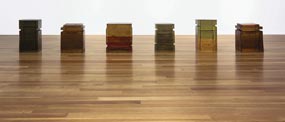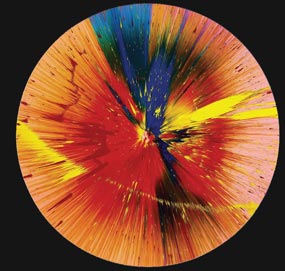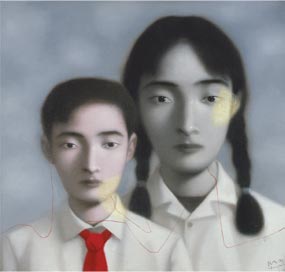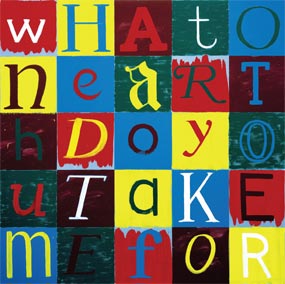
|
 |

To have to hold
Collecting art is no longer just about individual taste or the status of owning a wellknowncultural artefact, it is now a serious investment in its own right. Leading art adviser Richard Thompson offers some advice on how to play the market.
Over the past ten years, the art world has seen the term ‘investment’ go from being adirty word to part of the lingua franca. In this sense, the art industry has truly comeof age; it is now worth $3 trillion and has an annual turnover of $30 billion. It has its own indexes for tracking performance (MEI Moses All Art Index, artprice.com andartnet.com), showing that the returns are just as attractive if not better than the share market.It is now possible to commission a special report on any piece of art, and all of the relevantstatistics for making an informed purchase are just a click away. In a global economy that craves diversification of discretionary income, art is the hip newmust-have investment. Art funds have emerged as passive vehicles for reduced risk investment,spreading their buying across multiple disciplines and historical periods. Their boards andexpert advisers are some of the most respected personalities in their fields. The best example of an art fund with a proven track record is the Fine Art Fund, based inthe UK. CEO Philip Hoffman, who was formerly financial director at Christie’s and has 20years’ experience in analysing art as an investment, says: ‘Art is now recognised as a lucrativealternative asset class. History shows that art offers high returns and reduced portfolio volatility.The facts are there; from 1965 to 2002 the MEI Moses All Art Index (at 10.94%) outperformedboth the S&P 500 (at 10.49%) and government bonds (at 7.53%). ‘Furthermore, art market trends bear little correlation to equities or bonds, so there is greatpotential for portfolio benefits. This strategy enabled a realised cash-on-cash return of 47.6% at the end of 2006. In addition, art offers glamourand style - what would you rather have on yourwall, a stock certificate or a Pollock?’
Areas of opportunity The term investor did not enter the equationwhen I started out. There is no tried and testedformula for art buying. It is more to do withconnoisseurship and connections. As with anyinvestment, expert advice can provide insideinformation that can lead to bigger returns.Canvassing a number of opinions can give you ageneral idea of emerging areas of opportunity. Buying art for quick returns is a bad idea. Ifyou purchase works that challenge and inspireyou, it is less likely that you will want to partwith them. This means that you get the longtermbenefits of holding them and will bemore likely to weather any unfavourable marketchanges. Focusing on a particular area of interestis the best way to quickly gain knowledge andbecome an astute investor. Developing relationships with dealers or artexperts and artists makes the experience ofcollecting more enriching. It allows you insidethe machine to witness the inner workings,turning you into an integral cog, a participantrather than a spectator. Carving out a market As collectors’ walls fill up, they move tothe next available space - the floor andexterior. Modern grand houses are once againincorporating large-scale outdoor sculpture intotheir overall design. Commissioning sculpturesis an enjoyable process, offering a uniqueopportunity to meet and work with an artist.Involving artists at the early stages of planningcan create some exciting developments betweenarchitect, interior designer, landscaper and artist,resulting in a distinctive point of difference. |
Eastern promise
The Indian market has seen prices rise twentyfoldsince 2000. Worldwide sales of Indian artwere worth $200 million in 2005. Artists towatch include Tyeb Mehta and Francis Souza.The 2006 summer auction season saw 55 worldrecords broken. The emergence of Russia, Chinaand India as significant new investors in the artmarket has fuelled the growth figures. Art lesson Collector Nick Rhodes says: ‘In the early 1980sI had the great fortune to meet [art dealer] YvesArman, with whom I whiled away a long NewYork evening chatting about our favourite painters. ‘As I was leaving town a few hours later, Ipersuaded him to take me back uptown to openup the gallery so that I could view his currentMarcel Duchamp show. It was at this momentthat I became fascinated with editions. It didn’tseem to matter that each piece was not unique;in fact, it added to the mystique that there wereseveral identical artworks around the world inother collections. Given the monumental risein art prices in recent years, the editions marketlooks increasingly attractive for people looking tobuildtheircollections.The pricesnow beingachieved for editionsby artists such as Warhol,Bacon, Koons and Richter are atestament to the strength of this genre.’This has also been the case when you look atthe very healthy increases in value for the printsand multiples sector. An ‘editioned’ painting byGerhard Richte, which was published by ParkettMagazine and sold for less than €10,000 in 1996,is now selling for €125,000.
High-quality small-edition artworks by leadingartists are fantastic investments. They are ideal forthe boat, beach house, office or jet and allow buyersto risk buying challenging art by younger artists. Art buyers have become more discerning, lookingfor art that offers more than mere decoration.The emerging artists market is fresh and exciting,and cutting-edge purchases are great conversationstarters. They can reinvigorate seasoned collectorsand expand their knowledge and acceptance ofnew concepts in contemporary art. Even relatively new and emerging marketslike contemporary photography are performingbeyond expectation. Between January 1996 andno one should be in anydoubt that art is now aserious business. September2006, the price index for photographsby artists born after 1945 has risen 262%. Recent examples include Andreas Gursky’s ‘99cent’, which sold for $2 million on 10 May 2006,becoming the most expensive contemporaryphotograph on the market. Or names such asRichard Prince, whose works generated €4.7million at auction in 2005, demonstrate thevibrant growth of this relatively new market. The market has exploded in recent years andno one should be in any doubt that art is nowserious business. As an investor, if you keep aneye on new talent and emerging trends, theopportunities are endless. |
|||









